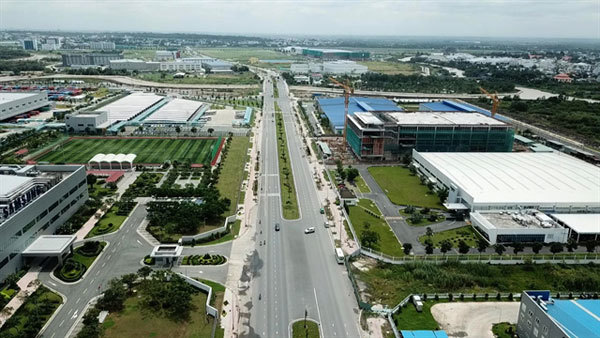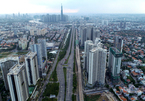 |
|
Saigon High-Tech Park in HCM City’s District 9 is one of the three 'main pillars' in the planned eastern innovative urban area.
|
The city government has approved merging the three eastern districts of 2, 9, and Thu Duc into one administrative unit to form an innovation hub in its east.
The hub will cover more than 211sq.km and be home to more than 1.1 million people. It is expected to promote economic growth in the city and the southern region.
It will serve as a centre for three main functions: scientific and technological research and application; education and training of high-quality human resources; and production and trade of hi-tech products and services.
It is expected to contribute a third of the city’s GDP, accounting for 7 per cent of national GDP.
Since 2018, the city has been working on the project to build the eastern innovative urban area based on three "main pillars": Saigon High-Tech Park (SHTP) in District 9, Thu Thiem New Urban Area in District 2 and the Vietnam National University HCM City (VNU-HCM) in Thu Duc District.
The SHTP is considered the nucleus for development of the eastern innovation urban area. It provides and nurtures scientific and innovative ideas, and attracts investment capital and quality human resources in high-tech fields that adapt to Industry 4.0.
In the last four years, it had total export value of US$46.36 billion. Last year, total export value reached $17.24 billion.
Enterprises in the SHTP have increasingly contributed to the state budget, from $123.36 million in the 2011-15 period to more than $1 billion in the 2016-19 period, an increase of more than 8.1 times.
State budget revenues collected from the enterprises is expected to increase from this year because enterprises have run out of preferential tax policies.
SHTP is entering a new stage of development, aiming to become a smart, innovative technology park in the next five years. Its management board has actively promoted a programme to develop high-technology supporting industries, and increase the added value of the domestic trade sector.
It is also stepping up the use of artificial intelligence (AI) technology in administrative management towards a modern governance model.
It plans to upgrade the research and development (R&D) centre into a research and development institute, the incubation centre into an innovation centre, and the training centre into a training institute for high-quality human resources.
The park has also strengthened connections between Vietnamese and FDI firms, VNU-HCM and enterprises, and bilateral and multilateral cooperation between experts in science and technology, and between experts and enterprises.
Nguyen Anh Thi, head of the SHTP management board, said the future direction for SHTP’s development would be associated with the development of the eastern innovative urban area.
It has set out three main tasks, the first of which is to build policies, improve quality and efficiency of foreign investment by 2030, and attract foreign investment in a selective manner focusing on quality, efficiency, technology and environmental protection as the evaluation criteria.
The second task is to speed up the implementation of investment projects in the SHTP’s 93ha Scientific Space, enhance linkages of all enterprises and between enterprises and universities and research institutes. This aims to raise the innovative potential of enterprises and boost production of high-tech products.
Thirdly, the SHTP will be a scientific-technological park which will play a role as a hub for research on science and technologies, and technological applications and transfers; and will serve as a link to research developing the innovation urban area.
The Thu Thiem new urban area project was approved by the Government in 1996 and has taken more than 10 years to complete site clearance. More than 99 per cent of land in the proposed area has been cleared.
The new urban area will cover 657ha on Thu Thiem Peninsula in District 2 and faces downtown District 1 across the Sai Gon River. Its land lots will be developed for both public services and commercial purposes.
District 2, including the Thu Thiem new urban area, is expected to become a financial complex and an important part of the planned eastern innovation urban area.
VNU-HCM ready for connection
As one of the three main pillars in the eastern innovative urban area, VNU-HCM is seen as a training centre for high-quality human resources and a scientific research centre for various fields.
Covering a total area of more than 643ha, VNUHCM is one of the country’s largest educational organisations. It has 36 units for training, scientific research and technology transfers, including seven member universities.
It trains about 69,000 undergraduates and postgraduates every year, and has a teaching staff of more than 1,300 people with doctorates and 400 professors and associate professors.
The university has developed close relations between the State, scientists and enterprises.
Its Information Technology Park (ITP) has been assigned to set up a research group for the establishment of the eastern innovation urban area. The ITP will begin as a startup ecosystem, and then become a centre for entrepreneurship and innovation in the information and communications technology sector.
Thanks to its advantages, VNU-HCM is the ideal place for innovation and start-ups as well as business incubation. VNS

HCM City’s future must look to the East
The East - Thu Duc City will be the nucleus for Ho Chi Minh City to develop a knowledge-based economy and build a smart city.

New Thu Duc City to be set up within HCM City as special, livable innovation area
Thu Duc is expected to be the ‘nucleus’ of HCM City’s implementation of a smart, knowledge-based city, according to Director of HCM City Planning and Architecture Department Nguyen Thanh Nha.